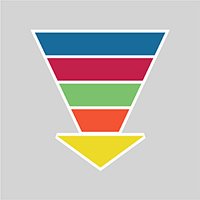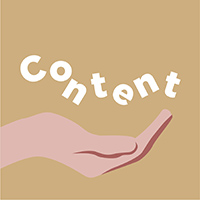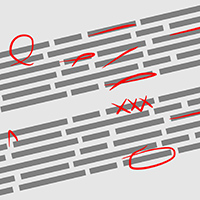Podcast: Play in new window | Download | Embed
Today’s Guest
The first guest I brought back for another conversation.
Elisa Doucette joins the 56th session of Smart Brand Marketing.
When I first spoke with Elisa. She was just moving away from freelancing and started her new company. It’s been almost two years since then and I wanted to see how things have been going since.
Everyone of us experiences ups and downs except we usually do not speak about it. Sort of… some do… there’s this failure glorification that goes on in some corners of the world. Lets leave that to the snowflakes.
Elisa popped up on my radar again by posting a review of 2017. It was brutally honest and took a lot of courage to post publicly. I loved it.
Press play!
TOPICS DISCUSSED
- How Elisa’s business has grown
- Marketing strategies
- Team Building
- Writing vs Editing
- Biggest mistake made
- Training process
- Online course
- Tips for editing
Enjoy!
What is the Content Creation Process?
When you first embark into the world of internet marketing, there is always this one rule that you are quickly introduced to:
Content is King
No matter what marketing strategy you use or what platform you advertise in, how effective you are as a marketer will be determined by the quality of the content you produce, use, and re-use.
With that in mind, it pays that you should take a look as to how your business creates in content. But what is the content creation process exactly? To answer that, let us look at a few basics first.
What is Content?

This is a broad question since content itself covers multiple media and can come in various forms. For instance, there is video content which can be uploaded in sites like YouTube. Then there is written content like articles, blog posts, and social media posts. Of course, there multi-media content that feature text-based, audio, video, and images at the same time.
Simply put, it’s everything that you can ever read, listen to, and watch on the Internet. It can be shared, downloaded, and curated for future use and will be always available so as long as a copy of it exists somewhere in the online world.
Why do We have to Create Content?
Now why do we have to create content? The answer is simple: to get people to convert. Every online business out there wants visitors to convert into customers and this can’t be done unless you offer them something of value. That something of value comes in the form of content.

For example, you might be the owner of a cleaning supplies store. If you want to subtly convince your audience to try out your products, you can post certain articles online that cover the basics of cleaning various surfaces in the house. Of course, you can have native promotions done for your brand but, on their own, they won’t do much to funnel traffic to your sites.
Even if you don’t put a call to action in your articles (which is important, mind you) you are effectively giving your readers something valuable in the form of information. This keeps your audience engaged with your brand which, with further compelling, might just cause them to convert into customers and then promoters.
Every content that you will find in the Internet is made for this purpose: to engage with a target market. Regardless if that article has a hard sell or was just made to tell a story, content serves as the bridge between your brand and your target audience in the online world.
How to Create Content
As your marketing campaigns rely heavily on the content you produce, you should at least try to understand what the creation process is. This will differ greatly from one content type to another but it will always involve certain stages.
-
1. Planning and Research

First and foremost, you need to establish the goals for your marketing campaign. After all, these would dictate the kind of content you will make as well as their overall theme and/or narrative.Aside from defining your goals, you should identify also the target audience for your content. Normally, your brand’s target market will be your audience but this can be further subdivided into other factors including the types of websites they go.
For example, social media sites like Facebook are frequented by children, teenagers, young adults, and adults while YouTube is used heavily by younger demographics specifically. The point here is this: you must identify where your target market goes to in order provide content that will fit the culture of those platforms.
-
2. Creating a Content Plan

Once you have identified your goals and your audience, you must then start laying out a draft of what your content would look like. First, decide on what kind of content do you want to produce. For starters, written content like articles and blogs are recommended as they are easy to digest and are readily available regardless of Internet speeds.However, if you have the equipment (and the confidence), you can start producing other more interactive content like videos and audio. These should allow you to engage better with your audience (as they can see and hear you) but they do take more time and effort to create.
Regardless of what content you plan to create, it should contain 3 distinct qualities:
- Informative – It covers a specific topic and details every important point there.
- Evocative – It should illicit a response of sorts from your audience whether emotional or intellectual. Of course, one of those responses should involve something beneficial for the businesses like them subscribing to your mailing list or purchasing from your site so a good call-to-action is a must.
- Shareable – Sharing is a basic feature in any site right now but being shareable is a quality that only good content produce. Your content should have a message the resonates with your audience to the point that they would actually press that share button after going through the entire article or video.
- Informative – It covers a specific topic and details every important point there.
-
3. Creation

Whatever form your content takes in, it should always be divided into three different parts.
- The Title/HeadingThis informs the audience as to what topics your content is going to cover. Keep it short, simple, and concise.
- The BodyThis part basically covers every detail of the topic you are discussing. Also, this is where you will do most of the informing and/or compelling with your audience. As such, you should have your message laid out in a way that it remains cohesive from beginning to end.
- The Call to ActionAfter learning something valuable from you, you should have your audience do something for you in return. Your call to action can involve anything as simple as subscribing or going to a separate page for more details or something more tangible like purchasing something. Whatever the case, your CTA should be compelling enough that your audience does the thing that you ask them to.
-
4. Editing, Monitoring, and Updating
Once you have finished your content, all that is left to do but to publish it in the Internet. However, that does not mean that your work with it is done. You will have to track its progress in your audience. How did your audience respond to the content? Was there any significant change in your site’s traffic once the content has been published?
Aside from that, there might be little errors in the content that you need to fix or update. Whatever the case, it is a must that you monitor how your audience is interacting with your content as the information you get here will be useful when you create future content.
The Writer and the Editor: Which is which?
Creating content is not exactly as straightforward as you think it is. There are two key roles that play in the creation of the content: the writer and the editor.
You might get confused as to what part they play in the content creation process but, make no mistake, they are distinct from each other. Here’s how.
The Writer Creates, the Editor Perfects
From an intellectual standpoint, the writer and the editor uses two different parts of the brain.

- For the writer, they rely more on the right side since this is the more creative part of the brain. As for editors, their work requires analysis and logic which would mean that they will have to use the left side of the brain more.
- The writer will be the one to form the narrative that dictates the flow of the story. Their work involves capturing the audience with the words they use in tandem with imagery, audio, and video. A writer is responsible for making the content exciting, engaging, and informative.
The editor, on the other hand, will have to make sure that whatever the writer creates follows the standards of language and grammar as well as the context of the medium where it is going to be published. They can also fill in the gaps made by the writer or bridge two different sections of the entire piece.
- Writers simply create without paying too much attention to conventions, putting their thoughts into words as ideas flow. Things like spelling, paragraphs, word choice, and formatting mean little to them.
As for the editor, it’s their task to mold whatever is given to them into something that is simple and easy to understand. This might include tasks like revising, removing unwanted paragraphs, and addressing issues in spelling, sentence structure, and grammar.
What Does All of this Mean, Then?
Since the editor and the writer fulfill two different roles, it only means that there should be no confusion whatsoever in what they do. To streamline things, writers must never edit and editors must never write.
If one person fulfills the same role, they should never do an editor’s and writer’s work simultaneously. First, they must create the piece tasked to them before critiquing and editing. Editing as you write can take up a lot of brainpower which could cause you to lose time.
Let the words flow from your brain to your pen (or keyboard) and do the editing later on. Of course, you can address mistakes as they appear but never to the point that you do major revisions while you are still completing the entire piece. The less you mix these two different roles, the better you can keep up with your production schedule.
Making Your Content Stand Out
Creating content is not enough these days. You should also make them stand out from the competition in the market. To do this, here are a few tips.
-
1. Develop Your Own Style

One of the biggest mistakes you can make as a content creator is copying someone else. When James Rolfe created the Angry Nintendo Nerd persona in his YouTube Channel, other people followed suit and started publishing their own “angry person that reviews old stuff” content.As of now, The Angry Nintendo Nerd is pretty much alive while the rest of the copycats have almost died out. Sure, channels like the Angry Joe Show and the Nostalgia Critic continue to remain popular today but copycats like the Irate Gamer never even reached the mid-2010s.
You must quickly find your niche in the market and then develop a style that speaks out to that crowd. The less you copy styles in the market, the less you are going to look like a fraud.
-
2. Mix and Match Content Types

As of now, search engines favor multimedia content as they are more visually appealing. When it comes to articles, make sure that you pepper some images here and there since the brain tends to retain information faster if it is accompanied by images.As for videos, well, they’re already multimedia in nature so linking to them from time to time would be an effective strategy.
Of course, there is the option to convert your content into different mediums. For instance, you can use your article as a basis for topics in a Podcast or as a script for a video. What you will end up is a library of content that support each other as far as topics are concerned while also funneling traffic from one page to another.
-
3. Interact with the Comments
The best content creators out there treat their pieces as an opportunity to start a conversation. Once you have published your content, you should maintain an active presence once the comments start pouring in.
Responding to comments is a good way of telling your audience that you are there to provide them with something of value. Of course, not every conversation online should be beneficial for you or your audience but being part of the conversation is far better than disappearing after your piece goes online.
In Conclusion
Creating content, in most cases, is a trial and error affair. There is no telling if you can get good in the content creation process until you have an entire library’s worth of it.
Until then, the best that you can do is to plan the content you create and, of course, create it. If you can avoid many major mistakes in content creation or, at the least, learn from them, you can maintain a competitive edge in your market.
What other problems have you faced creating content? Are there other content creation strategies that you use? Let us know in the comments below.
References:
https://mshannonhernandez.com/the-writer-vs-the-editor-dont-confuse-the-roles/
https://contentmarketinginstitute.com/2016/04/mistakes-content-creators/
RESOURCES
THANK YOU FOR LISTENING!
To get more SBM content sent directly to your device as they become available, you can subscribe on iTunes or Stitcher!
Also, reviews on iTunes are extremely helpful and greatly appreciated! I read each and every one of them, and feel free to share your URL there so I can contact you later on and say thanks!
If you enjoyed this episode you may also love listening to:



